Standing tall in the heart of Jaipur’s old city, the Swargasuli Tower, also known as Isar Lat, is one of the most iconic landmarks of the Pink City. Built in 1749 AD, this seven-storeyed minaret is not only Jaipur’s tallest historic structure but also a symbol of victory and pride for the Rajput rulers.
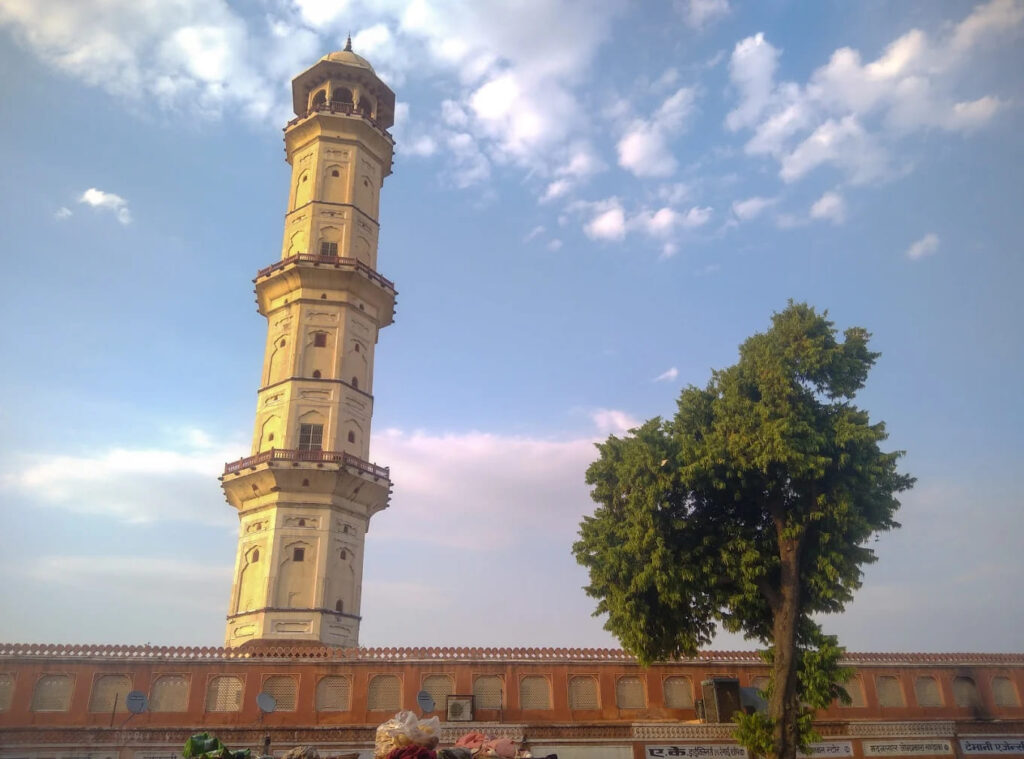
The word “Swargasuli” translates to “Tower to Heaven”, perfectly describing its majestic height and spiritual symbolism. Rising up to nearly 140 feet, the tower dominates Jaipur’s skyline and offers breathtaking panoramic views of the Pink City, including Hawa Mahal, City Palace, Jantar Mantar, and the bustling Tripolia Bazaar.
Unlike other monuments that emphasize grandeur at the ground level, Swargasuli Tower invites visitors to climb its spiral staircase and witness Jaipur from above, a perspective that beautifully captures the blend of royal architecture, heritage markets, and vibrant city life.
For history lovers, architecture enthusiasts, and photographers alike, the Swargasuli Tower Jaipur is a must-visit attraction that combines cultural significance with unforgettable views.
History of Swargasuli Tower Jaipur
The Swargasuli Tower, also called Isar Lat, holds an important place in the history of Jaipur. It was built in 1749 AD by Maharaja Sawai Ishwari Singh, the eldest son of Maharaja Sawai Jai Singh II (the founder of Jaipur).
Why Was It Built?
- The tower was constructed to commemorate Maharaja Ishwari Singh’s victory in a major battle, particularly his triumph over rivals from Amer and Marwar.
- It was also intended to showcase Jaipur’s growing strength and unity under his reign.
- Symbolically, the tower was designed as a “victory monument”, representing a bridge between the earth and the heavens.
Historical Significance
- The tower’s local name, Isar Lat, comes from “Ishwari,” a tribute to the king who commissioned it.
- Over time, it became known as the Swargasuli Tower (Swarga = Heaven, Suli = Path), meaning “Pathway to Heaven”.
- It served as a watchtower for royal guards, giving them a strategic view of Jaipur’s walled city and marketplaces.
- Today, it stands not only as a piece of history but also as a heritage symbol of Jaipur’s valor and architectural excellence.
Connection with Jaipur’s Legacy
The Swargasuli Tower is often compared to Delhi’s Qutub Minar, though smaller in height. However, unlike Qutub Minar, this tower was built more for symbolism and city viewing rather than religious purposes. Its presence highlights Jaipur’s unique mix of Rajput pride and Mughal-inspired architecture.
Architecture & Design of Swargasuli Tower Jaipur
The Swargasuli Tower (Isar Lat) is a fine example of Jaipur’s blend of Rajput and Mughal architectural styles, reflecting both grandeur and functionality. Standing at a height of about 140 feet (42 meters), it is the tallest historical structure in Jaipur, often compared to the Qutub Minar of Delhi.
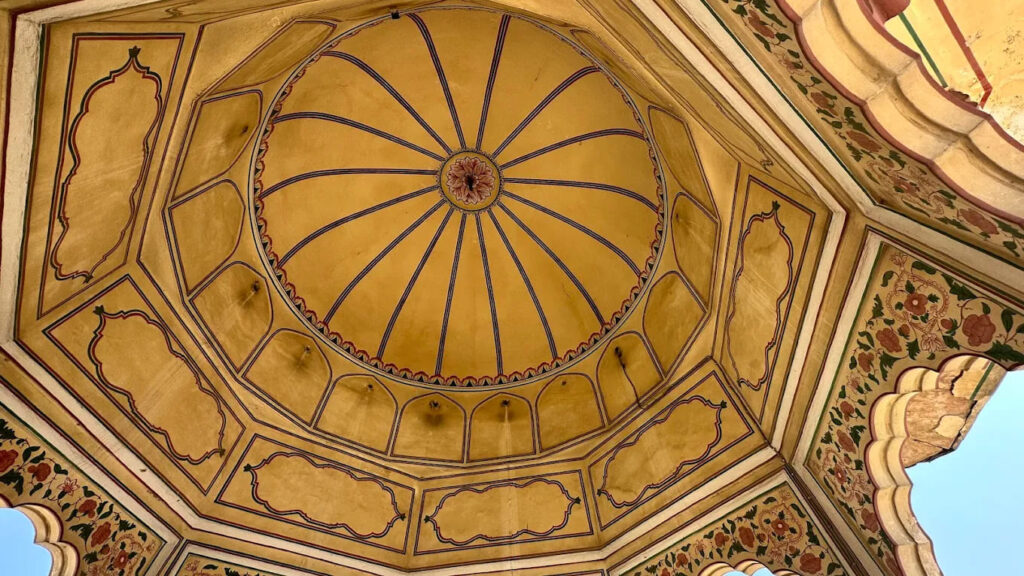
Structural Features
- Seven Storeys: The tower rises to seven levels, each marked by intricately carved arched windows (jharokhas) and projecting balconies.
- Octagonal Shape: Its unique octagonal design gives it both stability and elegance.
- Spiral Staircase: Inside, a narrow spiral staircase with around 264 steps takes visitors to the top, where panoramic views of the city await.
- Materials Used: Constructed using yellow sandstone and lime mortar, the tower has withstood centuries of time and weather.
Architectural Influence
- Inspired by Mughal-era minarets, yet retaining Rajputana touches in the detailing.
- Decorative elements include jaali work, domes, and arches, showcasing Jaipur’s craftsmanship.
- Each floor has openings that allow natural light and ventilation, making the climb less tiring and visually engaging.
The Viewing Gallery
The top floor has a small observation deck from where visitors can enjoy breathtaking views of:
- Hawa Mahal and City Palace
- Jantar Mantar (UNESCO World Heritage)
- Bustling Tripolia Bazaar and Jaipur’s Pink City streets
- The Nahargarh Hills in the distance
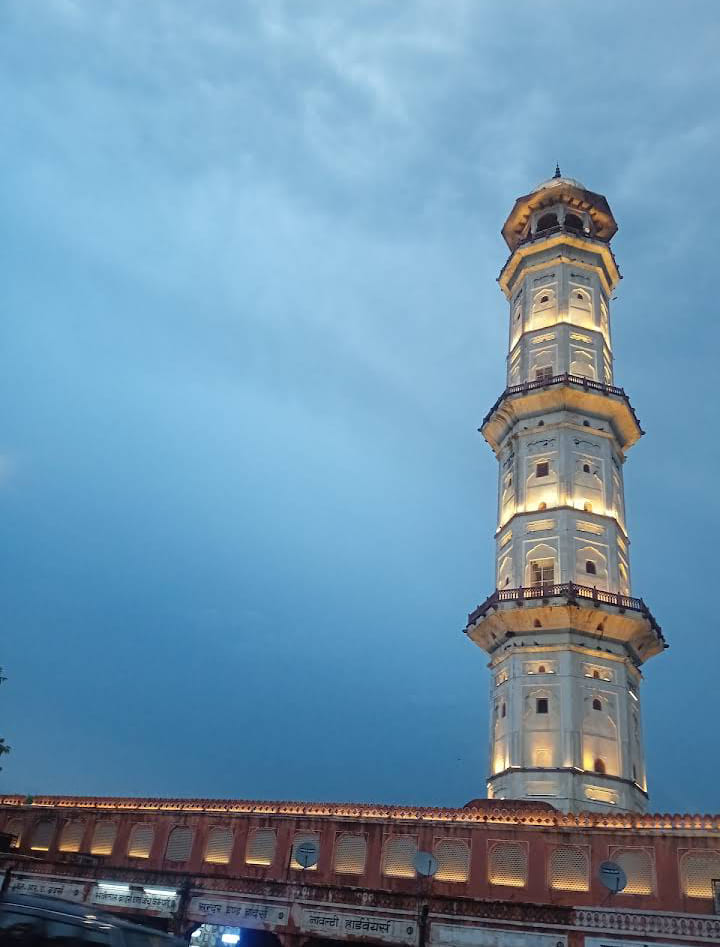
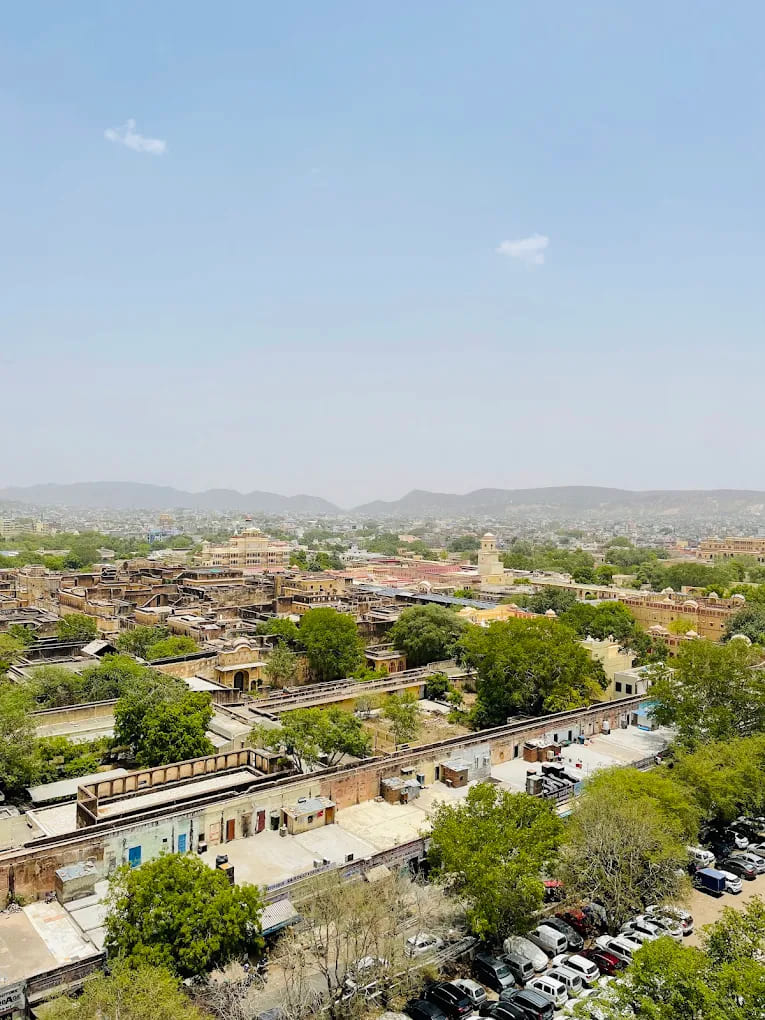
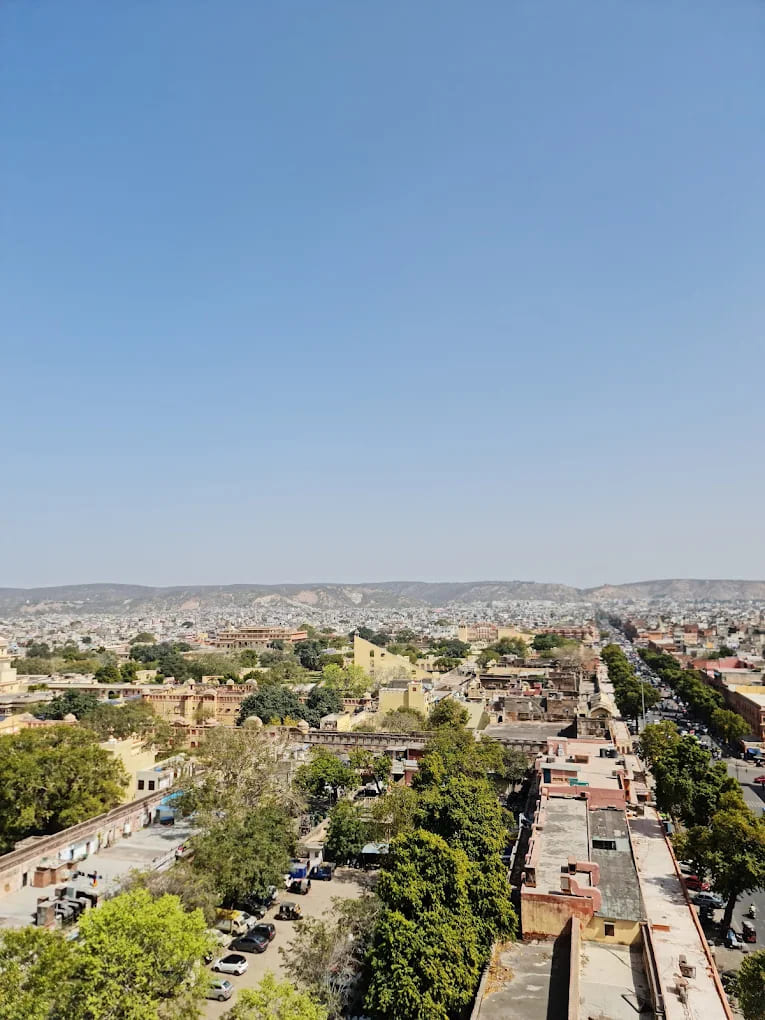
Symbolism in Design
Unlike a purely defensive watchtower, the Swargasuli Tower was designed as a “Path to Heaven”, symbolizing victory, pride, and spiritual elevation. Its soaring height represents Jaipur’s ambitions and the glory of its rulers.
Timings & Entry Fee of Swargasuli Tower Jaipur
Visiting the Swargasuli Tower (Isar Lat) is a memorable experience, offering not only a glimpse into Jaipur’s glorious past but also stunning 360° views of the Pink City. To make the most of your visit, here are the updated timings and entry details:
Opening Hours
- Daily: 9:30 AM – 4:30 PM
- The tower remains open throughout the week, including weekends and public holidays.
- Visiting early in the morning or late afternoon is recommended to avoid harsh sunlight, especially during summer.
Entry Fee
- Indian Visitors: ₹50 per person (approx.)
- Foreign Tourists: ₹200 per person (approx.)
- Children (below 7 years): Free entry
Best Time to Visit in a Day
- Morning Hours (9:30 AM – 11:00 AM): Pleasant and less crowded, ideal for photography.
- Evening Hours (3:30 PM – 4:30 PM): Perfect for panoramic sunset views of Jaipur.
Best Things to See & Do at Swargasuli Tower Jaipur
The Swargasuli Tower (Isar Lat) is more than just a historical monument – it’s a vantage point that lets visitors experience Jaipur from an entirely different perspective. Here are the highlights and must-do experiences when visiting this iconic tower:
1. Climb the Spiral Staircase
- The tower has a narrow spiral staircase of about 264 steps leading to the top.
- The climb itself is an adventure, giving a sense of the monument’s height and strength.
- Small jharokhas (arched windows) at each level allow you to pause, look outside, and catch partial views of the city.
2. Enjoy Panoramic Views of Jaipur
- From the top, the 360-degree view of Jaipur is simply breathtaking.
- You can spot major landmarks like:
- Hawa Mahal
- City Palace
- Jantar Mantar
- Tripolia Bazaar
- Nahargarh Fort in the distance
- Photographers especially love capturing the Pink City’s skyline from here.
3. Sunset & Sunrise Photography
- The tower is a favorite among photography enthusiasts.
- Morning hours provide clear blue skies, while evenings offer magical sunset hues over Jaipur.
- A must-do for travelers who want postcard-worthy shots.
4. Explore Jaipur’s Old City Around the Tower
- Located near Tripolia Bazaar, the tower is surrounded by vibrant markets.
- After your climb, stroll around to shop for handicrafts, jewelry, and textiles in Johari Bazaar and Bapu Bazaar.
5. Experience Jaipur’s Heritage
- Unlike other heritage sites, this tower offers both history and experience.
- It allows you to feel connected with how Jaipur’s rulers and guards once watched over their city.
Location & How to Reach Swargasuli Tower Jaipur
The Swargasuli Tower, also known as Isar Lat, is located in the heart of Jaipur’s old city near Tripolia Bazaar. Its central position makes it easy to include in a sightseeing tour of the Pink City.
Temple Address / Location
📍 Swargasuli Tower (Isar Lat), Tripolia Bazaar, Jaipur, Rajasthan – 302002
Google Location Map: https://maps.app.goo.gl/YM6MvBD9xVUonpNB6
It is situated close to some of Jaipur’s most famous landmarks like Hawa Mahal, City Palace, and Jantar Mantar, making it a convenient stop for tourists.
How to Reach
By Air
- The nearest airport is Jaipur International Airport (JAI), about 12 km away.
- From the airport, you can hire a taxi, cab (Ola/Uber), or auto-rickshaw to reach the old city.
By Train
- The nearest station is Jaipur Junction Railway Station, approx. 4–5 km from the tower.
- Auto-rickshaws and prepaid taxis are easily available outside the station.
By Road
- Jaipur is well-connected by national highways and intercity buses.
- The nearest bus terminal is Sindhi Camp Bus Stand, about 3.5 km away.
Local Transport Options
- Auto-rickshaws and E-rickshaws: Cheap and convenient for short distances.
- Cycle Rickshaws: Traditional way to explore the old city lanes.
- Cabs & Taxis: Ola, Uber, and local taxis are widely available.
Distance from Major Landmarks
- City Palace Jaipur → 500 m
- Hawa Mahal (Palace of Winds) → 700 m
- Jantar Mantar → 600 m
- Albert Hall Museum → 3 km
- Jaipur Airport → 12 km
Best Time to Visit Swargasuli Tower Jaipur
The Swargasuli Tower (Isar Lat) can be visited throughout the year, but the experience varies depending on the season and time of day. Choosing the right time ensures you enjoy both the climb and the panoramic views of Jaipur to the fullest.
Seasonal Guide
- October to March (Winter & Spring)
- The best season to visit Jaipur.
- Pleasant weather makes climbing the spiral staircase comfortable.
- Perfect for sightseeing and photography.
- April to June (Summer)
- Jaipur faces extreme heat, with temperatures often above 40°C.
- If visiting during summer, plan for early mornings (before 11 AM) or late afternoons (after 3:30 PM).
- July to September (Monsoon)
- The city looks fresher and greener.
- Occasional rains may limit visibility, but the view of rain-washed Jaipur can be spectacular.
Best Time of Day
- Morning (9:30 AM – 11:00 AM): Clear skies, cooler weather, and fewer crowds.
- Evening (3:30 PM – 4:30 PM): The golden sunset light makes for breathtaking views and stunning photographs.
During Festivals
Visiting around Diwali or Teej Festival adds extra charm. The entire city is lit up, and the view from the top of the tower during these celebrations is unforgettable.
Nearby Attractions Around Swargasuli Tower Jaipur
The Swargasuli Tower (Isar Lat) is located in the bustling old city of Jaipur, surrounded by some of the most popular monuments and markets. After climbing the tower and enjoying its panoramic views, you can easily explore these nearby attractions:
1. City Palace Jaipur
- Just 500 meters away.
- The royal residence of the Jaipur Maharajas.
- Famous for Mubarak Mahal, Chandra Mahal, Diwan-i-Khas, and museums showcasing royal costumes, weapons, and artifacts.
2. Jantar Mantar (UNESCO World Heritage Site)
- Located about 600 meters from Swargasuli Tower.
- An 18th-century astronomical observatory built by Maharaja Sawai Jai Singh II.
- Houses massive instruments like the world’s largest sundial.
3. Hawa Mahal (Palace of Winds)
- Around 700 meters from the tower.
- Known for its 953 small jharokhas (windows) built for royal women to observe street festivals unseen.
- A must-visit for photography lovers.
4. Tripolia Bazaar
- The tower itself stands in Tripolia Bazaar, one of Jaipur’s oldest markets.
- Famous for lac bangles, textiles, brassware, and traditional handicrafts.
5. Johari Bazaar & Bapu Bazaar
- Located within 2 km.
- Johari Bazaar → Famous for gems, jewelry, and precious stones.
- Bapu Bazaar → Popular for block-printed textiles, mojari footwear, and souvenirs.
6. Albert Hall Museum
- About 3 km from the tower.
- Rajasthan’s oldest state museum, showcasing Indo-Saracenic architecture and rare collections, including an Egyptian mummy.
7. Nahargarh Fort (Scenic Viewpoint)
- Located around 8 km away.
- Offers spectacular bird’s-eye views of Jaipur, especially at sunset.
Travel Tips for Visitors to Swargasuli Tower Jaipur
Visiting the Swargasuli Tower (Isar Lat) is a rewarding experience, but since it’s an old heritage monument with a steep climb, a few travel tips will help you enjoy your visit comfortably and safely.
1. Wear Comfortable Shoes
- The tower has a narrow spiral staircase with 264 steps.
- Comfortable footwear is a must for climbing up and down.
2. Carry Water & Stay Hydrated
- There are no water facilities inside the tower.
- Carry a small bottle, especially in summer months.
3. Photography Tips
- The view from the top is one of the best in Jaipur, so don’t forget your camera or phone.
- Sunrise and sunset are the best times for photography.
- Use the small windows at each level for creative shots of Jaipur’s streets and bazaars.
4. Best Visiting Hours
- Mornings (9:30 – 11:00 AM) and late afternoons (3:30 – 4:30 PM) are ideal.
- Avoid peak noon hours during summer as the climb may feel exhausting.
5. Mind the Staircase
- The staircase is steep and narrow, so climb slowly and carefully.
- If crowded, wait at the landings (jharokhas) to let others pass.
6. Family & Kids
- Suitable for families, but small children and elderly visitors may find the climb challenging.
- Always hold children’s hands while on the stairs.
7. Combine with Other Attractions
- Plan your visit along with City Palace, Jantar Mantar, Hawa Mahal, and Tripolia Bazaar.
- A combined itinerary will give you the best experience of Jaipur’s old city.
FAQs About Swargasuli Tower Jaipur
What is Swargasuli Tower famous for?
Swargasuli Tower, also known as Isar Lat, is Jaipur’s tallest historic tower. It is famous for its seven-storey structure and the panoramic views of the Pink City from the top.
Who built Swargasuli Tower in Jaipur?
The tower was built in 1749 AD by Maharaja Sawai Ishwari Singh to commemorate his victory in battle and to symbolize Jaipur’s strength.
How tall is the Swargasuli Tower (Isar Lat)?
The tower stands at about 140 feet (42 meters) and has seven stories connected by a spiral staircase.
Where is Swargasuli Tower located?
It is located in the Tripolia Bazaar area of Jaipur, close to City Palace, Hawa Mahal, and Jantar Mantar.
What are the timings of Swargasuli Tower Jaipur?
The tower is open daily from 9:30 AM to 4:30 PM.
What is the entry fee for Swargasuli Tower?
Indians: ₹50 per person (approx.)
Foreigners: ₹200 per person (approx.)
Children below 7 years: Free entry
How many steps are there in Swargasuli Tower?
There are around 264 spiral steps leading to the top of the tower.
What is the best time to visit Swargasuli Tower?
The best time is during October to March in the morning (9:30–11:00 AM) or evening (3:30–4:30 PM) for clear views and great photography.
